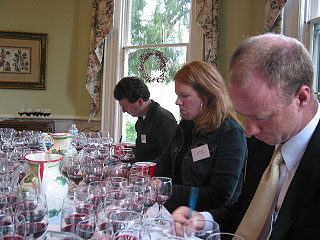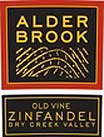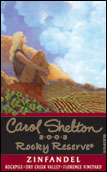Discovery Program

Confirmation panelists, Alder Yarrow, Heather Irwin,
and Jim Rolleston, work their way through a flight
of 2003 Zins from Dry Creek Valley.
Identifying the Appellation Characteristics of Dry Creek Valley Zinfandel
by Thom Elkjer, Regional Editor
2003 Dry Creek Zinfandel is proof that appellation matters. Nature can be unkind in terms of vintage weather, it appears, but its gifts to Dry Creek Valley in terms of soil, drainage, site inclination, and other factors remain as advantageous as ever.
On the morning of December 7th, 2005 AppellationAmerica’s Dry Creek Discovery and Confirmation Panels convened at The Gables Inn, an 1877 Sonoma County landmark that has no doubt seen more vintages of Zinfandel than most buildings anywhere. The estimable innkeepers, Mike, Pam and Jason Stanbrough, were on hand to help with hospitality and the logistics of hosting such a large tasting. A total of 38 Zinfandels from the Dry Creek Valley appellation (primarily from the 2003 vintage) were tasted double blind in two equal flights, in random order.
Both panels occupied their own table and conducted their own tasting, evaluation, and discussion before the conversations were combined. The identities of the wines were not disclosed until the end of the joint discussion, to keep panelists focused on themes common to the wines, the appellation, and the vintage. Upon disclosure of wine identities, technical data about the growing and vinification of each wine was also provided to panelist. The highlights of the discussion follow below in the “Discovery Record of Proceedings”.
Dry Creek Valley Zinfandel:
Typical Dry Creek Zinfandel exhibits ripe dark fruit characteristics including blackberry and black cherry aromas and flavors with a peppery spiciness, and good body with fine tannins.
In the unusually hot 2003 vintage, the quality and style of wines was erratic with the majority of Dry Creek Zins revealing what can be considered a-typical characteristics, including a “dried red-fruit” profile and greater astringency.
The Discovery Record of Proceedings
The main feature of the 2003 vintage in Dry Creek Valley was exceptional heat.
Veteran vintners Dave Rafanelli and Jim Pedroncelli, who grew up in the wine business in Dry Creek Valley and now lead their respective wineries, described 2003 as one of the hottest vintages in memory. Doug Nalle and Julia Iantosca, who have each made wine in the appellation for 20+ years, called 2003 a “winemaker vintage,” meaning that winemakers were not able to simply apply good technique to well-ripened fruit. Instead they had to bring all their skills and ingenuity to bear to respond effectively to what nature did to the grapes.
Zinfandel is an uneven ripener in the best of vintages. In the sustained summer heat of 2003, this inherent tendency went wild, often resulting in bunches that included desiccated raisins, “cooked” (overripe) grapes, and “shot” berries that never ripened. In Rafanelli’s words, “2003 magnified all the defects of the Zinfandel grape.”
Such a heat-induced combination could lead, unchecked, to wines of exceptionally high alcohol. Evidence of the winemakers’ response can be inferred from the average alcohol level of the wines tasted, which was 14.8% -- not much higher than average for North Coast Zinfandel today, even from Dry Creek Valley despite its history of claret-style Zinfandels with comparatively moderate alcohol. Most of the wines were in the 14% range; 11 wines were 15% or higher, and four were less than 14%. Overall, this analysis suggests that fermentations may have been managed to reduce alcohol conversion; alcohol levels may have been lowered subsequent to fermentation; or a combination of both.
Managing alcohol, however, does not alter flavor profiles.
The Discovery Panel was unanimous in identifying or articulating differences between 2003 Dry Creek Zin and other vintages. Nalle pointed out that few of the 2003 wines tasted offered the ripe blackberry aromas and flavors he generally looks for in Dry Creek Zin (and which the Panel pointed out were in abundance in the young wines of vintage 2005). Carol Shelton described the “spiciness” and “light floral perfume, like dried violets” that she associates with Dry Creek Zin, and observed that these qualities were muted or missing in many wines. The Confirmation Panel agreed with these points. Jim Rolleston spoke for his fellow Panelists in saying that “we saw less pepper and spice than we expected, and found the fruit to be more dried than ripe.”
Rafanelli noted that one reason for the “dried” impression was the lighter, redder fruit profile compared to what is normal for Dry Creek Zin. Because of this, the use of new oak barrels in aging “showed through more.” Shelton and others followed by observing that “the oak treatments in these wines were all over the map.” Iantosca described this as one of the main reasons that “there was no strong theme of integration or balance in 2003. We usually have good general juiciness and plenty of body along with fine tannins, but in 2003 there’s more astringency, more variation in body, and more aggressiveness in the tannins.”
Asked to describe the good qualities of the vintage, the Panel responded with a spirited defense of Dry Creek Valley.
All the Panelists made 2003 wines under their own labels that are 100% Zinfandel -- meaning they did not take the easy way out of a tough vintage by blending in (legally) high percentages of other grapes. Even in tough years, Iantosca declared, “we pull tasty bunnies out of the hat.” Other panelists pointed to the “serviceable” qualities of the wines on the table. “Drink them with a good cut of meat, and leave some of the fat on it,” Nalle suggested. “Don’t think too hard,” Rafanelli quipped. “Just drink and enjoy.”
Seen from this perspective, 2003 Dry Creek Zinfandel is proof that appellation matters. Nature can be unkind in terms of vintage weather, it appears, but its gifts to Dry Creek Valley in terms of soil, drainage, site inclination, and other factors (including vintners who tend to work in the appellation for much or all of their careers) remain as advantageous as ever.
The “Appellation Signature” Wines
The Discovery Panel reached consensus on five wines it felt carried an Appellation Signature for Dry Creek Valley Zinfandel in 2003. (Quite interesting was that none of these was produced at a winery represented by a Discovery Panelist.) The Confirmation Panel nominated an additional wine and argued convincingly that it bridged regional and vintage-specific characteristics. (This wine turned out to have been made by one of the Discovery Panelists.)

The resulting six “Appellation Signature” wines are listed below alphabetically rather than in any order of preference.
Both panels occupied their own table and conducted their own tasting, evaluation, and discussion before the conversations were combined. The identities of the wines were not disclosed until the end of the joint discussion, to keep panelists focused on themes common to the wines, the appellation, and the vintage. Upon disclosure of wine identities, technical data about the growing and vinification of each wine was also provided to panelist. The highlights of the discussion follow below in the “Discovery Record of Proceedings”.
Dry Creek Valley Zinfandel:
The Discovery Record of Proceedings
The main feature of the 2003 vintage in Dry Creek Valley was exceptional heat.
Veteran vintners Dave Rafanelli and Jim Pedroncelli, who grew up in the wine business in Dry Creek Valley and now lead their respective wineries, described 2003 as one of the hottest vintages in memory. Doug Nalle and Julia Iantosca, who have each made wine in the appellation for 20+ years, called 2003 a “winemaker vintage,” meaning that winemakers were not able to simply apply good technique to well-ripened fruit. Instead they had to bring all their skills and ingenuity to bear to respond effectively to what nature did to the grapes.
Zinfandel is an uneven ripener in the best of vintages. In the sustained summer heat of 2003, this inherent tendency went wild, often resulting in bunches that included desiccated raisins, “cooked” (overripe) grapes, and “shot” berries that never ripened. In Rafanelli’s words, “2003 magnified all the defects of the Zinfandel grape.”
Such a heat-induced combination could lead, unchecked, to wines of exceptionally high alcohol. Evidence of the winemakers’ response can be inferred from the average alcohol level of the wines tasted, which was 14.8% -- not much higher than average for North Coast Zinfandel today, even from Dry Creek Valley despite its history of claret-style Zinfandels with comparatively moderate alcohol. Most of the wines were in the 14% range; 11 wines were 15% or higher, and four were less than 14%. Overall, this analysis suggests that fermentations may have been managed to reduce alcohol conversion; alcohol levels may have been lowered subsequent to fermentation; or a combination of both.
Managing alcohol, however, does not alter flavor profiles.
The Discovery Panel was unanimous in identifying or articulating differences between 2003 Dry Creek Zin and other vintages. Nalle pointed out that few of the 2003 wines tasted offered the ripe blackberry aromas and flavors he generally looks for in Dry Creek Zin (and which the Panel pointed out were in abundance in the young wines of vintage 2005). Carol Shelton described the “spiciness” and “light floral perfume, like dried violets” that she associates with Dry Creek Zin, and observed that these qualities were muted or missing in many wines. The Confirmation Panel agreed with these points. Jim Rolleston spoke for his fellow Panelists in saying that “we saw less pepper and spice than we expected, and found the fruit to be more dried than ripe.”
Rafanelli noted that one reason for the “dried” impression was the lighter, redder fruit profile compared to what is normal for Dry Creek Zin. Because of this, the use of new oak barrels in aging “showed through more.” Shelton and others followed by observing that “the oak treatments in these wines were all over the map.” Iantosca described this as one of the main reasons that “there was no strong theme of integration or balance in 2003. We usually have good general juiciness and plenty of body along with fine tannins, but in 2003 there’s more astringency, more variation in body, and more aggressiveness in the tannins.”
Asked to describe the good qualities of the vintage, the Panel responded with a spirited defense of Dry Creek Valley.
All the Panelists made 2003 wines under their own labels that are 100% Zinfandel -- meaning they did not take the easy way out of a tough vintage by blending in (legally) high percentages of other grapes. Even in tough years, Iantosca declared, “we pull tasty bunnies out of the hat.” Other panelists pointed to the “serviceable” qualities of the wines on the table. “Drink them with a good cut of meat, and leave some of the fat on it,” Nalle suggested. “Don’t think too hard,” Rafanelli quipped. “Just drink and enjoy.”
Seen from this perspective, 2003 Dry Creek Zinfandel is proof that appellation matters. Nature can be unkind in terms of vintage weather, it appears, but its gifts to Dry Creek Valley in terms of soil, drainage, site inclination, and other factors (including vintners who tend to work in the appellation for much or all of their careers) remain as advantageous as ever.
The “Appellation Signature” Wines
The Discovery Panel reached consensus on five wines it felt carried an Appellation Signature for Dry Creek Valley Zinfandel in 2003. (Quite interesting was that none of these was produced at a winery represented by a Discovery Panelist.) The Confirmation Panel nominated an additional wine and argued convincingly that it bridged regional and vintage-specific characteristics. (This wine turned out to have been made by one of the Discovery Panelists.)

The resulting six “Appellation Signature” wines are listed below alphabetically rather than in any order of preference.
- Alderbrook Vineyards & Winery
“Old Vine” Zinfandel, Dry Creek Valley, 2003 (14.3%)
Ripe red plums dominated the aromas and flavors, followed by black cherries and toasted oak. Fine, ripe tannins and well-modulated oak flavors complemented the fruit and conferred good balance. The wine finished as it started, with red plums, black cherries and smooth oak. - Carol Shelton
“Rocky Reserve” Zinfandel, Rockpile - Florence Vineyard, 2003 (14.1%)
Very sweet blueberry and blackberry fruit aromas and flavors with a good contributi






